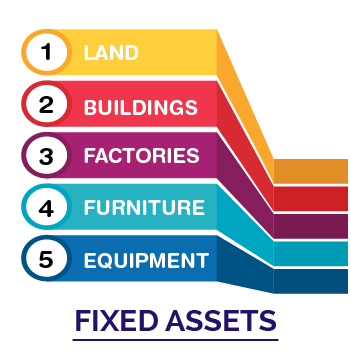Fixed assets definition
Fixed assets are the long term tangible assets that are used by business in generating income. Fixed assets provide the firm with long term financial gain as they have a useful life of more than one year. Fixed assets are also known as capital assets and are denoted by the term Property, Plant and Equipment in the balance sheet. Fixed assets cannot be easily converted into cash.
Significance of Fixed Assets

An elucidated representation of an establishment’s capital sums up to the comprehending of the financial profit and evaluation of that business concern. Information incorporating fixed assets and depreciation is additionally used by financial experts when they are thinking about whether an establishment is a non-profitable or profitable enterprise. While ascertaining the profitable of a fixed asset, the plan of action for depreciation has to be contemplated.
Types of Fixed Assets
- Tangible Assets: Tangible asset is an asset that has a physical existence. Tangible assets examples are land, buildings and machinery.
- Intangible Assets: An intangible asset is an asset which doesn’t possess a physical existence. Brand recognition, intellectual property, goodwill and such as copyrights, trademarks, and patents are all examples of intangible assets.
Also Read: Types of Current Assets
Fixed Asset Formula
| Net Fixed Assets = Total Fixed Assets – Accumulated Depreciation |
Accounting for Fixed Asset
Accounting for fixed assets involve recording of several transactions for fixed assets which can be as follows:
- Recording of asset : This is the first type of accounting entry for the purchase of the asset. In case the asset is purchased with credit, then the entry will be a credit to the account payable and debit will be on the respective fixed asset account.
- Depreciation: Fixed assets undergo depreciation with time in accounting. Several methods are used to determine depreciation. Of the methods, straight line method is the most popular method.
- An asset based upon it’s useful life will function in the organisation. After that period it must be scrapped or sold. It is performed by debiting the accumulated depreciation account of all depreciation charges and crediting the respective fixed asset account.
Depreciation in Fixed Assets
Depreciation is the part of a fixed asset’s cost listed as an investment during the present accounting years. In other words, a fixed asset has a valuable long life for more than one accounting period, therefore, depreciation refers to the fraction of its value used during the current years.
Depreciation can be measured in various ways. Simplest is the Straight-line depreciation, separating the fixed asset’s cost by the number of accounting years it is expected to last.
| Important Topics in Accountancy: |
Fixed Assets Examples
Fixed assets are fixed in nature and cannot be easily convertible into cash. Below is the list of fixed assets.
- PPE (Property, Plant, and Equipment)
- Land
- Buildings
- Vehicles
- Furniture
- Machinery
Also Read: Tips to Study Accountancy
The above mentioned is the concept, that is elucidated in detail about ‘What is a Fixed Asset?’ for the Commerce students. To know more, stay tuned to BYJU’S.
